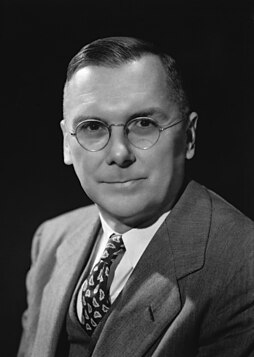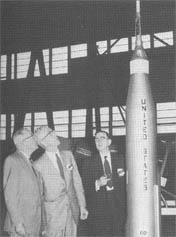
Luna 10 was a 1966 Soviet lunar robotic spacecraft mission in the Luna program. It was the first artificial satellite of the Moon.
CiteSeerX is a public search engine and digital library for scientific and academic papers, primarily in the fields of computer and information science. CiteSeer is considered as a predecessor of academic search tools such as Google Scholar and Microsoft Academic Search. CiteSeer-like engines and archives usually only harvest documents from publicly available websites and do not crawl publisher websites. For this reason, authors whose documents are freely available are more likely to be represented in the index.

The National Advisory Committee for Aeronautics (NACA) was a United States federal agency founded on March 3, 1915, to undertake, promote, and institutionalize aeronautical research. On October 1, 1958, the agency was dissolved and its assets and personnel were transferred to the newly created National Aeronautics and Space Administration (NASA). NACA is an initialism, i.e., pronounced as individual letters, rather than as a whole word.
A technical report is a document that describes the process, progress, or results of technical or scientific research or the state of a technical or scientific research problem. It might also include recommendations and conclusions of the research. Unlike other scientific literature, such as scientific journals and the proceedings of some academic conferences, technical reports rarely undergo comprehensive independent peer review before publication. They may be considered as grey literature. Where there is a review process, it is often limited to within the originating organization. Similarly, there are no formal publishing procedures for such reports, except where established locally.

Hugh Latimer Dryden was an American aeronautical scientist and civil servant. He served as NASA Deputy Administrator from August 19, 1958, until his death.

Abraham "Abe" Silverstein was an American engineer who played an important part in the United States space program. He was a longtime manager at the National Aeronautics and Space Administration (NASA) and its predecessor, the National Advisory Committee for Aeronautics (NACA). He was instrumental in the planning of the Apollo, Ranger, Mariner, Surveyor, and Voyager missions, and named the Apollo program after the Greek and Roman God.
PubMed Central (PMC) is a free digital repository that archives open access full-text scholarly articles that have been published in biomedical and life sciences journals. As one of the major research databases developed by the National Center for Biotechnology Information (NCBI), PubMed Central is more than a document repository. Submissions to PMC are indexed and formatted for enhanced metadata, medical ontology, and unique identifiers which enrich the XML structured data for each article. Content within PMC can be linked to other NCBI databases and accessed via Entrez search and retrieval systems, further enhancing the public's ability to discover, read and build upon its biomedical knowledge.
A bibliographic database is a database of bibliographic records, an organized digital collection of references to published literature, including journal and newspaper articles, conference proceedings, reports, government and legal publications, patents, books, etc. In contrast to library catalogue entries, a large proportion of the bibliographic records in bibliographic databases describe articles, conference papers, etc., rather than complete monographs, and they generally contain very rich subject descriptions in the form of keywords, subject classification terms, or abstracts.

Ira H. Abbott was an American aerospace engineer. After graduating from MIT, Abbott started working for Langley Aeronautical Laboratory in 1929. He contributed significantly to the establishment of high-speed research programs and published numerous technical reports on aerodynamics. He eventually attained the post of assistant chief of research at Langley in 1945.
CSA was a division of Cambridge Information Group and provider of online databases, based in Bethesda, Maryland before merging with ProQuest of Ann Arbor, Michigan in 2007. CSA hosted databases of abstracts and developed taxonomic indexing of scholarly articles. These databases were hosted on the CSA Illumina platform and were available alongside add-on products like CSA Illustrata. The company produced numerous bibliographic databases in different fields of the arts and humanities, natural and social sciences, and technology. Thus, coverage included materials science, environmental sciences and pollution management, biological sciences, aquatic sciences and fisheries, biotechnology, engineering, computer science, sociology, linguistics, and other areas.
CENDI is an interagency group of senior Scientific and Technical Information (STI) managers from 14 United States federal agencies. CENDI managers cooperate by exchanging information and ideas, collaborating to address common issues, and undertaking joint initiatives. CENDI's accomplishments range from impacting federal information policy to educating a broad spectrum of stakeholders on all aspects of federal STI systems, including its value to research and the taxpayer, and to operational improvements in agency and interagency STI operations.
Richard V. Rhode was an early aeronautical engineer at Langley Memorial Aeronautical Laboratory, who researched aerodynamic loading. He was awarded the Wright Brothers Medal in 1937 for this work. He continued doing secret aerodynamics-related research work during World War II, the results of which were later declassified.
The OpenSIGLE repository provides open access to the bibliographic records of the former SIGLE database. The creation of the OpenSIGLE archive was decided by some major European STI centres, members of the former European network EAGLE for the collection and dissemination of grey literature. OpenSIGLE was developed by the French INIST-CNRS, with assistance from the German FIZ Karlsruhe and the Dutch Grey Literature Network Service (GreyNet). OpenSIGLE is hosted on an INIST-CNRS server at Nancy. Part of the open Access movement, OpenSIGLE is referenced by the international Directory of Open Access Repositories.

Richard Harbert Smith was a professor and researcher of aeronautical engineering at the Massachusetts Institute of Technology (MIT), from 1929 to 1945.
Paul Richard Hill (1909–1990) was a mid–twentieth-century American aerodynamicist. He was a leading research and development engineer and manager for NASA and its predecessor, NACA between 1939 and 1970, retiring as Associate Chief, Applied Materials and Physics Division at the NASA Langley Research Center. He is arguably most widely known today as the author of Unconventional Flying Objects: a Scientific Analysis.

The German National Library of Science and Technology, abbreviated TIB, is the national library of the Federal Republic of Germany for all fields of engineering, technology, and the natural sciences. It is jointly funded by the Federal Ministry of Education and Research (BMBF) and the 16 German states. Founded in 1959, the library operates in conjunction with the Leibniz Universität Hannover. In addition to acquiring scientific literature, it also conducts applied research in such areas as the archiving of non-textual materials, data visualization and the future Internet. The library is also involved in a number of open access initiatives. With a collection of over 9 million items in 2017, the TIB is the largest science and technology library in the world.
NASA Alumni League is a U.S. organization that supports people that have worked for or at NASA or its predecessor NACA, to stay connected, and to "support the nation's space programs with technical expertise, educational outreach, and financial contributions to STEM organizations." The organization operates across the nation, also with state chapters that allow patrons to network locally. Three goals of NAL in the early 21st century were to "communicate with the NASA community", "to aid the NASA community with its comprehension of engineering and science, and "encourage members to participate in community service and in turn, encourage a dedication to the pursuit of scientific knowledge that benefits all humankind. " NAL is not part of NASA or the U.S. government, it is a non-profit organization founded in 1986.

CORE is a service provided by the Knowledge Media Institute based at The Open University, United Kingdom. The goal of the project is to aggregate all open access content distributed across different systems, such as repositories and open access journals, enrich this content using text mining and data mining, and provide free access to it through a set of services. The CORE project also aims to promote open access to scholarly outputs. CORE works closely with digital libraries and institutional repositories.

Pearl I. Young became the first female technical employee of the National Advisory Committee for Aeronautics (NACA), which evolved to become today's NASA. She became Chief Technical Editor at NACA's Langley Instrument Research Laboratory, and an engineering professor.

Prof. Alfred Gessow was an American pioneer in the field of helicopter aerodynamics and aerospace engineering. He was a co-author of the early rotorcraft engineering text, Aerodynamics of the Helicopter, which, although published in 1952, has been in print for more than 50 years. Gessow was chair of the Department of Aerospace Engineering at the University of Maryland, College Park, and was ultimately promoted to Professor Emeritus.










